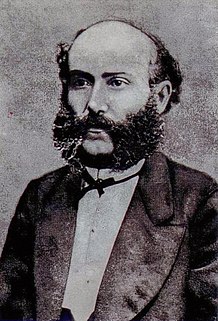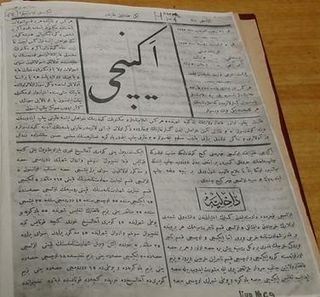
Telecommunications in Azerbaijan provides information about television, radio, fixed and mobile telephones, and the Internet in Azerbaijan. The Azerbaijan economy has been markedly stronger in recent years and, not surprisingly, the country has been making progress in developing ICT sector. Nonetheless, it still faces problems. These include poor infrastructure and an immature telecom regulatory regime. The Ministry of Communications and Information Technologies of Azerbaijan (MCIT), as well as being an operator through its role in Aztelekom, is both a policy-maker and regulator.

The Azerbaijan Democratic Republic, also known as Azerbaijan People's Republic, simply as Azerbaijan in Paris Peace Conference, 1919–1920, Caucasian Azerbaijan in some diplomatic documents abroad, was the third democratic republic in the Turkic world and Muslim world, after the Crimean People's Republic and Idel-Ural Republic. The ADR was founded by the Azerbaijani National Council in Tiflis on 28 May 1918 after the collapse of the Russian Empire. Its established borders were with Russia to the north, the Democratic Republic of Georgia to the north-west, the First Republic of Armenia to the west, and Iran to the south. It had a population of 2.86 million. Ganja was the temporary capital of the Republic as Baku was under Bolshevik control. The name of "Azerbaijan" which the leading Musavat party adopted, for political reasons, was, prior to the establishment of the Azerbaijan Democratic Republic in 1918, exclusively used to identify the adjacent region of contemporary northwestern Iran.

Alimardan Alakbar oglu Topchubashov was a prominent Azerbaijani politician, foreign minister and speaker of the Parliament of Azerbaijan Democratic Republic.

AzTV or Azerbaijan Television is a state-controlled national television channel in Azerbaijan. It is the oldest television channel in the country, having first broadcast from Baku on 14 February 1956 in what was then the Azerbaijan Soviet Socialist Republic, Soviet Union.

Hasan bey Zardabi, born Hasan bey Salim bey oglu Malikov, was an Azerbaijani journalist and intellectual, founder of the first Azeri-language newspaper Akinchi in 1875.

Akinchi, also transliterated as Ekinchi, was the first Azerbaijani-language newspaper, published in Baku between 1875 and 1877. It was the first newspaper fully printed in Azerbaijani, as well as the first newspaper in Russia printed in a Turkic language.
İctimai Television or İTV is a public television channel in Azerbaijan. It began broadcasting on 29 August 2005 after being created by law in 2004, as the first independent public broadcaster in Azerbaijan. The channel is based in Baku.
Access to the Internet in Azerbaijan is growing, supported by a national strategy to develop the country into an information and communication technology (ICT) hub for the Caucasus region. The Azerbaijani government actively seeks to attract foreign aid to help boost the telecommunications and ICT sectors. While the government claims 85 percent of the population was online in 2013, service provider Baktelekom has provided free wifi zones in several points of Baku like the National Flag Square, the Boulevard, Old City, the park around the Heyder Aliyev Centre, parks of Sahil, Sabir, Samad Vurghun, Winter Park, as well as Port Baku Residence and Port Baku Mall.

Idman Azerbaijan TV is a state-controlled television channel in Azerbaijan. It began broadcasting from Baku on 1 January 2009 and primarily airs live sporting events and sport-related programming.
Television in Azerbaijan was introduced in 1956, when Azerbaijan was still known as the Azerbaijani SSR.
Javanshir Mehdikhan Vаkilov was an Azerbaijani diplomat, candidate of historical science since 1988, public and political figure, writer and pedagogue.

Khosrov bey Pasha bey oglu Sultanov, also spelled as Khosrow Sultanov, was an Azerbaijani statesman, General Governor of Karabakh and Minister of Defense of Azerbaijani Democratic Republic.

The Azerbaijan State Academic Drama Theatre is an academic theatre of drama in Baku, Azerbaijan.

Aslan Ahmad Aslanov is a famous Azerbaijani journalist, Chairman of the Board of Azerbaijan State News Agency (AZERTAC), Honorary Culture Worker of the Azerbaijan Republic (2000), the holder of Tereggi medal (2005), Order for the Services to the Motherland (2010), Shohrat Order (2011), 20th Anniversary Medal of TURKSOY (2014), “Hasan bey Zardabi”, “Golden Pen” and “Supreme Media”, Jubilee Silver Medal of the Commonwealth of Independent States awards.
The story of the press in Azerbaijan began with Akinchi, the first Azerbaijani-language newspaper, published by Hasan bey Zardabi in Baku between 1875 and 1877. Other newspapers followed through the remainder of the 19th century. This was a time of emergence for Azerbaijani literature in general.
Muhammad Hassan Bey Veliyev-Baharly was a prominent Azerbaijani scientist, whose contributions in the studying field of ethnogenesis, economy are not only widely used by modern-day scholars, but represent the achievements of independent Azerbaijan Democratic Republic. Baharly was the first chief of Azerbaijani State Bank and a professor of Baku State University. He died as a result of political repressions, orchestrated by Josef Stalin.

The Hasanbey Zardabi Natural History Museum is a natural history museum in Baku, Azerbaijan.

Aflatun Amashov is the public and political figure of the Republic of Azerbaijan, well-known journalist and publicist, chair of the Press Council of Azerbaijan, Former Chairman of the "RUH" Committee for the Protection of the Rights of Journalists of Azerbaijan, Honorary Cultural Worker.

Sayyad Aran or Sayyad Salahly is an Azerbaijani social figure, candidate of Philological sciences (2005), one of the founders of New Azerbaijan Party, writer-publicist, and envoy of the Republic of Azerbaijan. Deputy for the I and II convocation of Milli Majlis of the Republic of Azerbaijan. First deputy chairman of the State Committee on Religious Associations of the Republic of Azerbaijan. Honored Journalist of the Republic of Azerbaijan.

Vagif Samadoghlu was an Azerbaijani poet, playwright, publicist, People's Poet of the Republic of Azerbaijan, Deputy of the National Assembly of the Republic of Azerbaijan.

















